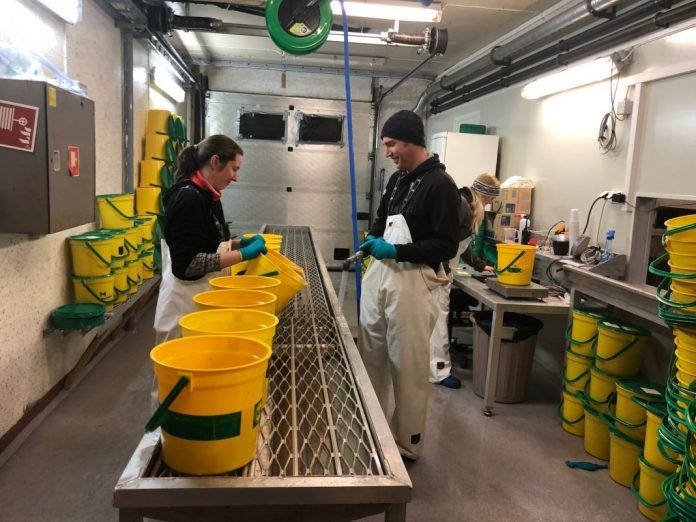The broodfish plant at Askøy is one of two Mowi-owned plants in Norway. The company produces 150 million eggs annually on its own for breeding stock.
“We only produce roe and do not have smolt facilities here. We produce significant quantities. Two broodfish farms on land and nine sites for broodstock in the sea. We produce 150 million newly fertilized roe a year,” said Hans Øyvind Svensvik, operations manager at Mowi Tveitevågen, to SalmonBusiness.
“We are the biggest in this, and we supply eggs to our entire system, including Scotland, Ireland and even the Faroe Islands in some cases. Chile and Canada have their own breeding strains. Chile has three strains, but the genetics part is increasingly controlled from Norway,” he said.

No feeding
When fat, large salmon are delivered to Mowi’s broodstock mid-May, they won’t absorb nutrients.
“There is no license here but we do have a permit for holding 15,000 broodstock. Here there is no feeding. The fish doesn’t eat. Not in the rivers either. It feeds on its own fat reserves. When the fish comes in here in May, it is fat and only fed on marine feed. And we see that at the egg quality,” he explained.
Out in nature in salmon rivers, the fish spawn from November to January. Mowi’s roe are light and temperature controlled to determine the spawning time.

“Our spawning season is from mid-September to early March. Then we have ready-for delivery eggs in week 45, beginning of November, until mid-August. That’s what we do without turning the clock completely for the fish. The Mowi strain has always been known for late spawning. We want late maturity. That means good growth,” he added.
The fish was originally sourced from the Western Norway rivers Vosso and Årøyelva, both known for large, strong salmon.
Six million in one day
“We expect groups to finish in late February/early March. We take out 400 female fish today. Then you can multiply it by 15,000 eggs. Today, six million eggs are fertilized. It’s a straightforward production day,” added Svensvik.
Broodfish, female fish of 15-16 kg, hang bleeding on hooks in the room next door. They have done their job. Now the next generation is taking over.
“There are 30,000 eggs in a bucket. This is equivalent to two lorries with fillets,” he said.
For today’s fertilisation, Sophie Lund adds sperm which was stored in a refrigerator, from a minimum of three males in each batch. She gets assistance from biologist Erik Tangset in her job as an obstetrician. One milliliter of sperm gives up to eight billion semen.
“A male fish fertilises on average eggs from a hundred female fish,” said Tangset.
“It gives us opportunities to use the very best fish,” chips in Svensvik.
Digital
Out in the hatchery, a screen shows digital scanning of each egg, which is pumped through a transparent tube, evaluated and passed on. At the plant, technology has made its mark, even out here.

The eggs are then stored in green coloured incubators.
“We put the fish in for 310 degree days. There are up to a million eggs in each incubator. We have over a hundred such. The eggs stay from eight weeks to close in six months. It is temperature dependent,” added Svensvik.

